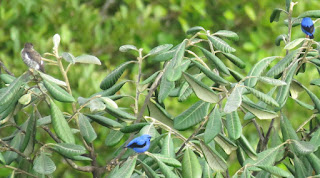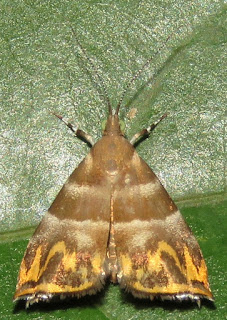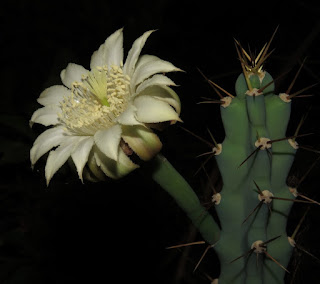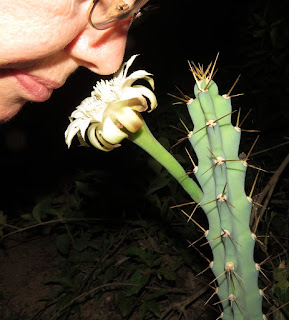January 12, 2020
This is the last morning at Cristalino Jungle Lodge for me and my remaining 31 friends who joined me for this half-century bash. Our departure isn’t until after 10:00 a.m., so while some chose to sleep in, pack, and hang out around the lodge clearing, I joined Gilmar and his group – which was now just Brad and Cindy – for a sunrise visit to Tower 2, named the Ted Parker Tower. This is one outing where hard-core birding groups usually get up later than general ecotourists – if you want to see the sunrise, you have to get there before birds are actually visible. Since Gilmar guides mostly non-birders, he scheduled us to depart well before it started getting light, and we hiked the kilometer by headlamp. The sunrise was gorgeous, worth the early start on its own, but we actually had some birds we would have missed with a typical birding arrival. As we got to the top, a pair of Short-tailed Nighthawks were calling close by, unseen. I whistled their staccato, slightly-upslurred note, and they circled us closely, but I never was able to get a glimpse against the dark canopy below. But looking above, the sky was getting light, and Brad spotted a nighthawk flying high – but this one was very high, making a beeline southward, and had the typical long, pointed wings of a Common Nighthawk, here on its wintering grounds.
As it got light, we delighted in lots of bird activity close to the tower, including Pompadour and Spangled Cotingas, toucans, aracaris, and parrots. One of the more surprising sightings was of a very young King Vulture perched in a distant tree, and we later learned that the group hiking to Serra 1 were on the trail below that bird and saw it as well. In this photo are a White-browed Purpletuft and two Short-billed Honeycreepers.
The light was also perfect for people watching on Tower 1.
As we gathered back at the lodge, we finished packing, put our bags out, signed the guest book, finalized our bar bills, and gradually gathered by the dock. But that took quite a while, and there was time to look for interesting things in the understory. This diurnal metalmark moth (family Choreutidae) is Ornarantia ophiodesma, rather common, but so small it’s often overlooked.
Steffen was looking for a reported turtle that walked away when he looked under a leaf and found this amazing caterpillar. It’s Parasa flora, a moth in the family Limacodidae.
Finally we were all together for this group photo. What an amazing group of people. I love you all.
The Brazilian guides were terrific, and I hope they had as much fun as the rest of us.
To the Pantanal: While all 32 of us flew from Alta Floresta to Cuiaba, we then split up a bit. Christoph went on to Curitiba and Iguazu, and 11 flew back to their respective homes. But 20 of us boarded two Mercedes Sprinters and began the 3-hour drive to the northern Pantanal for a 10-day extension that I organized with the help of my friends Giuliano and Lisa Bernardon of the travel company Birding Pantanal. They bought an old run-down lodge, fixed it up just this past year, renamed it Aymara, and we are among the first groups to stay here. We arrived after dark, and those on the left side of the first bus got to see an Ocelot on the entrance road to the lodge.
After we got a bit settled in and had dinner, most of us took a walk back down the entrance road hoping for some interesting mammals. We did see some Common Pauraques and heard plenty of frogs. This small Brazilian Orange-banded Tarantula, Acanthoscurria juruenicola, was on the side of the road.
For me the biggest thrill was finding this blooming cereoid cactus and then discovering that it smelled sweetly of ripe coconut! I’ve had it identified as Mirabella minensis, formerly Cereus mirabella.















No comments:
Post a Comment